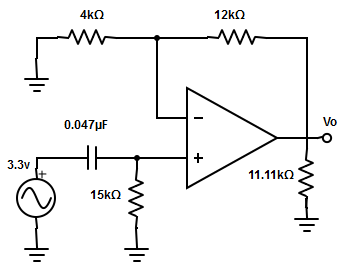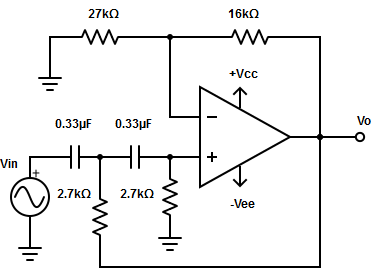1. How are the higher-order filters formed?
A. By increasing resistors and capacitors in low pass filter
B. By decreasing resistors and capacitors in low pass filter
C. By interchanging resistors and capacitors in low pass filter
D. All of the mentioned
2. In a first-order high pass filter, frequencies higher than low cut-off frequencies are called
A. Stopband frequency
B. Passband frequency
C. Centre band frequency
D. None of the mentioned
3. Compute the voltage gain for the following circuit with an input frequency 1.5kHz.

A. 4dB
B. 15dB
C. 6dB
D. 12dB
4. Determine the expression for the output voltage of the first-order high pass filter?
A. VO = [1+(RF /R1)]× [(j2πfRC/(1+j2πfRC.] × Vin
B. VO = [-(RF /R1)]× [(j2πfRC/(1+j2πfRC.] × Vin
C. VO = {[1+(RF /R1)]× /[1+j2πfRC] }× Vin
D. None of the mentioned
5. The internal resistor of the second-order high pass filter is equal to 10kΩ. Find the value of the feedback resistor?
A. 6.9kΩ
B. 5.86kΩ
C. 10kΩ
D. 12.56kΩ
6. Consider the following circuit and calculate the low cut-off frequency value?

A. 178.7Hz
B. 89.3Hz
C. 127.65Hz
D. 255.38Hz
7. Determine voltage gain of second-order high pass Butterworth filter.
Specifications R3 =R2=33Ω, f=250hz and fL=1khz.
A. -11.78dB
B. -26.51dB
C. -44.19dB
D. None of the mentioned
8. From the given specifications, determine the value of voltage gain magnitude of the first order and second-order high pass Butterworth filter?
Pass band voltage gain=2;
Low cut-off frequency= 1kHz;
Input frequency=500Hz.
A. First order high pass filter =-4.22dB , Second order high pass filter=-0.011dB
B. First order high pass filter =-0.9688dB , Second order high pass filter=-6.28dB
C. First order high pass filter =-11.3194dB , Second order high pass filter=-9.3257dB
D. First order high pass filter =-7.511dB , Second order high pass filter=-5.8999dB
9. How are the higher-order filters formed?
A. Using the first-order filter
B. Using second-order filter
C. Connecting first and second-order filters in series
D. Connecting first and second-order filters in parallel
10. State the disadvantage of using higher-order filters?
A. Complexity
B. Requires more space
C. Expensive
D. All of the mentioned
